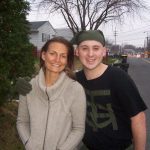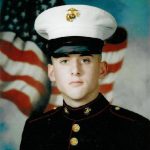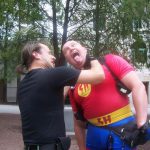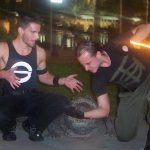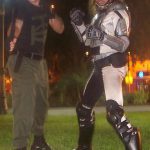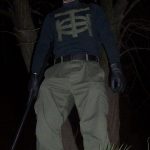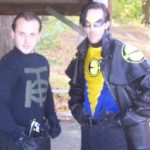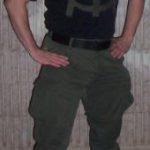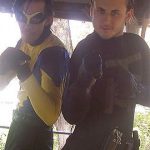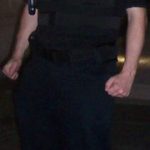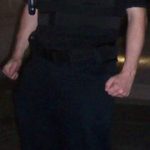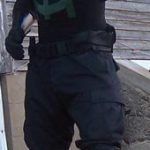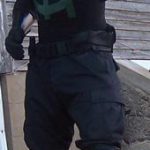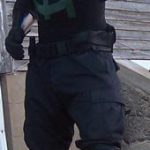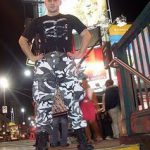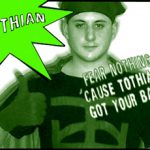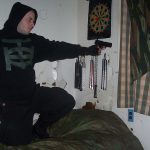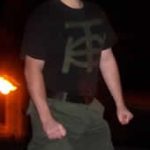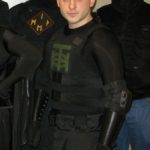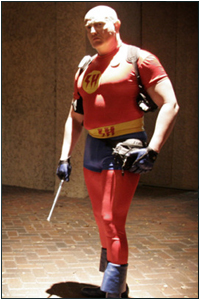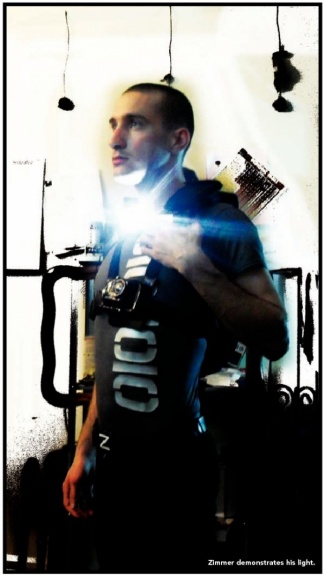By Joel Warner
You don’t exist. You think nothing, you feel nothing, you are nothing. That’s the secret to becoming invisible, to becoming the Wall Creeper.
And he is surely invisible tonight. No one notices as the lean nineteen-year-old makes his way across Civic Center Park and up the granite front steps of the State Capitol. He’s just another night prowler, bundled up against the cold in a black leather jacket.
Probably no one would pay attention even if he were wearing his full battle suit: The Kevlar composite vest, the blunt-trauma pads strapped to his martial arts-toned arms and legs, the custom-designed full-face covering purchased from Hero-Gear.net. Most people go through life in a stupor. It’s like what Master Legend — who’s been battling Florida evildoers for more than a quarter-century — says: “It’s not that a man becomes invisible; it’s just that a man becomes invisible to everybody else. If you are an outcast that nobody cares about, no one notices you.”
In other words, people don’t see what they don’t expect — and no one expects to see somebody like the Wall Creeper, a flesh-and-blood superhero.
Nevertheless, the Wall Creeper can’t risk wearing his battle suit. Not tonight, his first Denver patrol. He doesn’t yet know the city like he knows the Colorado mountain towns and rural communities he’s spent three years patrolling. Until he finds his footing here, there’s no need to attract attention. So all he carries, folded and tucked in his breast pocket, is the most important piece: the black mask he places over his mouth and nose like some terrible demon beak. It’s inscribed with an ornate “W” intertwined with a serpent-like “C” — the insignia of the Wall Creeper.
He paces at the foot of the Capitol building, waiting for his colleague Zen Blade to arrive. He’s edgy, too distracted by his nerves to scope out nearby walls and obstacles for footholds in case he needs to wall-creep to a good vantage point or escape route. He’s never met the Aurora crime fighter who wears a triple-crescent logo on his chest and knit cap, along with aviator-style goggles, but from what he’s learned of him online, the two have much in common. That’s why he contacted Zen Blade and suggested they meet up tonight, to join forces as they prowl the streets.
While the Wall Creeper waits, the city below him seethes. Somewhere nearby, a siren wails. In the shadows of Civic Center Park, a group of men holler and tussle. Maybe they’re playing around, maybe not. On the side of the Denver Newspaper Agency building, the block-long LCD news display scrolls through its never-ending inventory of despair. Drug dealers. Rapists. Pedophiles.
To the Wall Creeper, it seems that with each passing moment the world is getting worse, the shadows deepening, the hands ticking closer to midnight. That’s why he’s taking a stand, hopefully before it’s too late. He’ll stand guard, never resting, as it is written in Isaiah 62:6: “I have posted watchmen on your walls, O Jerusalem. They will never be silent day or night. Whoever calls on the Lord, do not give yourselves any rest, and do not give him any rest until he establishes Jerusalem and makes it an object of praise throughout the earth.”
A man in a black leather coat approaches. “Waiting for someone?” he asks.
“Zen Blade?” responds the Wall Creeper, extending a hand. Zen Blade, several years older and bulkier than Wall Creeper, left his suit at home, too, but is nonetheless ready to patrol. “Let’s go,” he says.
The night awaits.
Nobody knows my whole story,” the Wall Creeper says when he first consents to an interview. “Most nineteen-year-olds are just trying to get lucky and get drunk. I want to save the world. It’s taken over my life, and I’m happy with that.” But people need to know he’s not just some vigilante or costumed weirdo, he explains. (And, to be clear, he prefers to be called a crime fighter, not a defender, warrior or costumed activist. Worst of the bunch, he says, is probably “real-life superhero.” After all, no one would say “real-life police officer.”)
“My greatest desire is to aid the police in stopping crime in this great city,” he writes in an e-mail. “Every fiber of my being wants to patrol, to aid, to help the citizens of this city, and the
real heroes, the police and firemen, in Denver.”
To explain why, he agrees to meet — under strict and secretive conditions. He’ll only show up at a public, neutral location — a quiet park in a metro-area suburb near where he’s been patrolling the past few months or, on cold days, in a nearby chain restaurant. He wears unremarkable civilian clothes over his lithe physique, and there’s none of the swagger or eagerness of other guys his age. Smiles, for example, are few and far between. He’s the type who blends into a crowd, the last one anyone would expect to be rounding up villains or crushing crime syndicates.
He refuses to disclose where he lives. Anyone who knows, he explains, would be in danger if a criminal tried to use him to get to the Wall Creeper. “It’s like the Batcave,” he says wryly, though he’s quick to point out that he’s never been a big fan of comic books. Getting him to reveal his real name is clearly not an option.
The tale he divulges over several weeks is impossible to verify. He won’t disclose the names of relevant locations, and he says the few people who are close to him, like his father, are reluctant to talk. But the veracity of the events he describes seems less important than the assurance with which he describes them. Each of his stories, each of his memories, is real enough for him to have created the Wall Creeper.
He ran and ran. The freshman boy who would become the Wall Creeper ran every afternoon through the hot, barren plains of South Texas. He ran alone, three to four miles at a stretch, until he could hit a 5:25 mile and had somehow willed away his asthma attacks. He ran even though he hated it, even though it left him ragged for the grueling tae kwon do classes he took later each afternoon. He ran to keep sane, to block out the physical and verbal abuse he suffered at school. He ran so he’d be able to fight back.
And he ran because something inside him told him he had to, that the agony he felt was leading up to something, that he was destined for something great.
It wasn’t always like this. When he was younger, growing up in suburban Oklahoma, there was nothing to run away from. Playing street hockey, learning Christian ideals of right and wrong from his strict but loving parents, watching
Batman (the ones with Michael Keaton, whom he considers the only real Batman) — it all seemed right. He especially loved the peach tree in his yard, the one that grew fruit so fat and juicy it would split from within. He’d climb up the tree’s trunk and nap within its thick branches, just as he’d shimmy up light poles and scale chain-link fences. He climbed because it was exhilarating and was something no one else could do, and because at the top he got to live, just for a moment, in his own special world.
He can’t remember exactly when things changed. For reasons he can’t explain, his recollections are fractured and disjointed, his memory cut short by parts he seems to have blocked out. One of the turning points, however, came on a night when he was eleven or twelve. Walking home from a street hockey game, he saw a teenager leading away a young girl he knew, saying to her, “I’m going to take you home, and we’ll see what’s under your skirt.” Hearing that, something snapped. He attacked the teenager, he says, fighting until the older boy ran away. After that, things get fuzzy.
He says he took the girl to her empty house and, to watch over her once she was inside, quietly scaled the one-story residence and waited on the roof until her parents returned. That was his first “wall creep,” he says now, a technique that would later become his signature move. For a while, though, the whole episode seemed so incredible, he wasn’t sure it had actually happened; as he wrote about the wall-creeping part of the night in his journal last year, “Someone inside me (probably a lie) tells me this.”
Whatever happened, the episode changed him.
“That night, I realized the dark underside of the world,” he wrote. “People as a whole squirm and are crippled by their lies, false beliefs…expectations and society. This perversion could not be ignored by me…I decided to be something inhuman to exonerate myself from human weakness, at least in part.”
The human weakness he witnessed around him only worsened when, not long after this incident, he and his family moved to Texas. His memories of middle school there are bleak. A gray prison of a school building, with no heat or windows to let in the sun. First-period physical education classes spent running the school grounds in ragged gym clothes, the early morning haze illuminated by the piles of burning trash school workers would ignite. Bullies everywhere, attacking the new kid and scrawling curse words all over his clothes.
High school was no better. It was a sprawling warehouse-like place packed with 7,000 students. Someone like him got lost in the flood.
While he was locked away in these dismal fortresses, something new and fierce was growing inside him, struggling to get out. “In the turmoil of this dangerously weak emotional state was born a new face,” he says now. “While most kids my age succumbed to apathy, not really caring about others or what was morally right, I became filled with empathy, to the point where I knew I would sacrifice myself for another.”
He needed a body to match his taut new mental state, so he took up tae kwon do and a rigorous running regimen, even though he hated it. He had no choice, he told himself; he was destined for something great.
Pray for me.”
That’s what he said right before his first crime-fighting patrol. He was talking to a classmate at whose house he was spending the night. The classmate, a friend from his junior class, had agreed to help out with his crazy scheme. While the kid wasn’t coming along for the outing, he had offered his parents’ home as a base of operations, since it was located near the center of the Colorado mountain town where the would-be crime fighter and his family had moved from Texas the year before.
The Wall Creeper still shivers nervously thinking about that evening: how the two boys spent the hours leading up to the patrol, almost too anxious to talk. How glancing at the duffel bag of equipment he’d spent weeks preparing made him feel like he was about to get on a roller-coaster ride, one without a visible end. What would happen if he got caught? Would he be arrested? Would the embarrassment ruin his family? By 10 p.m., he’d done enough wondering. It was time to go.
He’d hatched the plan two months earlier, the day he claims he got a call from a police detective who was looking for a guy he knew, a friend of a friend who’d recently skipped town. The detective said the guy had been abusing a little girl. Afterward, he sat in his bedroom feeling trapped, all the old anger flooding back.
After moving to Colorado, things had briefly gotten better for the boy. His new school was small, intimate, populated with teachers and students who seemed to care. But then he started hearing about drugs at parties, stuff like heroin and ecstasy. Classmates he thought were respectable turned out to be dealers. And with each passing week, the local crime blotter filled with ever more reports of robberies, assaults and worse.
The detective’s call was the final straw. It seemed to him the town was falling apart, with the police too understaffed to do anything about it. The ones who’d suffer the consequences were the children — kids like his own little sister.
“I realized I was all alone against what was happening,” he says. “It was an innocent town, a loving town that turned to drugs. And my little sister was going to have to grow up in that, and I wouldn’t allow that.”
That night, surrounded by papier-mâché masks and fantasy posters he’d hung on his bedroom walls, he realized something incredible: Maybe he could make a difference. “I have been training. I can do something. It’s not like I am just some common guy,” he thought. “I’ve been training for this all my life and didn’t realize it.”
The creature struggling inside him was about to be let out. As an unassuming high school student, he had the perfect cover to learn about the drugs and dealers. He could handle himself in a fight, having continued his obsessive physical training. All he needed was a way to protect his identity in this insular mountain town.
In other words, he needed a battle suit. The outfit he built over the next two months was a mixture of practicality and drama, something he hoped would protect him but also strike fear into the hearts of evildoers. He bought a full-face balaclava from a ski shop, obtained a paintball ballistics vest from a military surplus store and salvaged the arm and leg pads he’d used in his street hockey days. Everything was black, to blend in with the night. He armed himself with swords, two short blades he named Twitch and Wind. And while the grappling hook he tried never worked, he was pleased with the black cape he’d designed with sewn-in umbrella ribs that he could raise like demon wings.
But he still needed a name, something terrifying. Since the Wall Creeper persona had yet to come to him, he instead thought back to the time as a toddler when he’d wandered into his family’s backyard playhouse and found its walls writhing with the pulsing wings of hundreds of moths. The door had slammed behind him and the creatures had taken flight, pouring over his tiny body, consuming him. He couldn’t remember what happened next — the memory breaks off — but the revulsion he still felt about it was enough to inspire the perfect name: the Mothman.
And now, as he stepped quietly out of his classmate’s house, the Mothman was ready to take flight.
The masked young man had no particular destination in mind as he walked down the quiet street that warm summer night. He was essentially taking his suit for a test drive, to see what might happen. He didn’t have to wait long to find out.
Just a few doors down, the Mothman froze as a motion-sensitive garage-door light flicked on, illuminating a deer on an evening stroll. He considered it for a moment, until he realized he wasn’t the only one watching. A couple was observing the deer from their nearby porch — and then turned and looked right at him.
He did the only thing he could think of. He raised his horrible black wings like some fiendish beast rearing out of the darkness. If this was to be the Mothman’s coming-out party, he’d be damned if he didn’t leave an impression.
That’s when the cop car rolled down the street.
He couldn’t believe it. What were the odds that one of the town’s meager police force would show up right here, right now? Instinctively, he dropped to the ground and covered himself with his cape, hoping, pleading, to blend into the foliage. The squad car cruised by without stopping. He sprinted back to his friend’s house, not bothering to look back. He’d only been gone twenty minutes and had nearly been caught. Still, he was exhilarated that he’d actually patrolled — and made it back in one piece.
And look on the bright side, he told himself. Things could only get better from here.
He soon discovered he wasn’t the only crime fighter, unbelievable as that seemed. The tip-off was Mr. Silent.
Several months after his first patrol, with several additional excursions under his belt, he came across a MySpace page for a man who patrolled Indianapolis armed with a cane, a gentleman’s suit and a silver mask. He excitedly sent Mr. Silent a message, letting him know that he, too, was a crime fighter. He received a response from a different superhero, a New York City-area avenger named Tothian. There are lots of us, Tothian explained, and encouraged him to join their ranks in the Heroes Network — a sort of United Nations for superheroes.
But first he’d need a new name. “Mothman” had lost its mystique when he’d realized it was similar to the name of a 2002 thriller starring Richard Gere. So he thought back to his alter ego’s origins, the night he silently scaled the wall of that little girl’s house. The answer was obvious: He was the Wall Creeper.
The Heroes Network embraced the Wall Creeper with open arms. Founded by Tothian in early 2007, the membership-only online forum covered everything from battle tactics to investigation tips, and boasted dozens of members from all over the country and beyond — people like Slapjack in Maine, Nostrum in New Orleans, Lionheart in England and the not-so-subtly named Superhero in Florida. From the Wall Creeper’s perspective, a few were clearly dressing in tights for attention or to live out some fantasy.
But many were like himself, people sick of the world’s depravity and apathy who’d decided to take matters into their own hands. Their outfits symbolized a pledge to justice. “Some would say the costumes are to inspire people to do good, to show people that there are people like us out there,” says the Wall Creeper. “This line of work isn’t just a job or career; it’s a piece of your life. It defines you, and it comes out in the pride you take in your costume.” Most of these costumed avengers know they have no real powers other than those provided by their training or equipment (though a few believe they have metaphysical abilities, including Master Legend, who says he can flip over a car and run at supersonic speeds without losing his breath). But that hasn’t stopped them from facing down evil on their own. They have no interest in joining structured operations like police forces or even the Guardian Angels. They live by their own rules.
“Justice is not the law,” Master Legend says, his declarative sentences seeming to come out in word bubbles. “Laws are written by men. Justice is written into our souls, our spirit, from the day we are born.”
No one knows for sure who was the first to heed this call for justice and strap on a mask. Some heroes have been around since the 1990s — folks like Mr. Silent, as well as Terrifica, a woman who dons a Valkyrie bra and defends ladies in New York City, and Superbarrio Gómez, a Mexico City resident who campaigns against corruption wearing a red and yellow wrestler’s mask. Then there’s Master Legend, who claims to have been taking down criminals with his “No Mercy Punch” since 1983. But even before him, there was the Human Fly, a costumed Canadian who in the 1970s rode on top of a DC-8 airliner and used a rocket-powered motorcycle to jump 27 buses at a Gloria Gaynor concert. He had a Marvel comic book named after him.
Lately, though, conversions to the superhero cause have reached a fever pitch, with the Heroes Network swelling to more than 300 members. So far, the Colorado contingent remains relatively small. There’s Tigris, who crusaded for animal justice for a while in Colorado Springs; Ten, who sports a blood-red mask and a mean pair of nunchucks; and a shadowy figure who answers to the name Nightwatch. None of them could be reached for this story. But Colorado’s superhero population may grow, especially with new crime-fighting associations such as the Signal Light Foundation and Superheroes Anonymous taking hold.
The recent upswing could be a response to real-world perils that seem straight out of a mega-villain’s plan for world domination, things like the 9/11 terrorist attacks, the bird flu and the USA PATRIOT Act. Or maybe it’s thanks to the Internet, with websites like the Heroes Network inspiring costumed crime fighters the world over to come out of the closet. Or maybe, as the Wall Creeper believes, it’s because few people look up to the military or elected officials or the police anymore. The only heroes left, it seems, are the mythical ones whose visages soar across movie screens and whose four-color exploits still embellish endless childhoods.
“The only role models we have left are either dead or gone or never existed,” he says. “It’s sad we have to take up that mantle waving a superhero flag.”
In the Heroes Network, the Wall Creeper finally felt part of something important.
“It was like coming home for the first time,” he says. “Just imagine having a friend in every state that knows what you do and how you are and everything.” With his online colleagues, he endlessly compared and fine-tuned his battle suit and tinkered with his MySpace page. He eventually sank more than $1,000 into his alter ego, explaining to his parents that it was going toward a paintball hobby. Along the way, he gathered trade secrets such as how capes, while dramatic, don’t work well in actual crime fighting. He discovered that the best place to buy handmade Spandex battle suits was
www.Hero-Gear.net — “We’ve got what it takes to be a HERO!” — and ordered a custom-designed mask from the site for special occasions. And from Entomo the Insect Man, a Naples, Italy-based superhero, he learned he needed an insignia that would set him apart from your everyday all-black ninja. “You are the only Wall Creeper,” Entomo told him. “There is no one else like you.” So the Wall Creeper painted an ornate “W-C” motif on his mask.
And now the man behind that mask felt like he was becoming a force to be reckoned with. He had to keep his secret from his parents — it was too dangerous and unconventional for them to know about — so a few times a week, he’d wait in his room until the house was silent before sneaking out. Then he’d navigate the moonlit three-mile walk to town before stealthily roaming the streets for hours looking for trouble.
He gave up his swords, preferring to rely on his detective skills and the three or four martial arts styles in which he’d taken lessons (though to keep the upper hand, he won’t say how, exactly, he’d handle himself in a fight). Some nights he’d “wall-creep” up buildings, climbing up fire escapes and vaulting over walls so he could run surveillance from roofs. He discovered he could become invisible just by thinking and feeling nothing — acting as though he didn’t exist. The tactic seemed to work, since he remembers only a handful of people ever noticing him. The few who did sometimes gasped or screamed, while others waved and wished him a good night.
One time, he says, he tracked a local drug dealer to his house and knocked on his window. When the thug got over the sight of a masked man peeking through his curtains, he allowed the Wall Creeper inside to talk. That night, the crime fighter learned about the OxyContin, heroin, cocaine, meth and ecstasy flowing freely under the direction of a local narcotics ring. He took it all down in his journal and warned the dealer that if he didn’t clean up his act, he’d be back.
Other than that, the Wall Creeper didn’t experience much in the way of dramatic confrontations. No matter: His main weapon wasn’t his fists, but the legend that he believed was growing. Sure enough, he sensed that rumors were spreading around school of a masked vigilante, and to him it seemed that the once-rampant drug trade petered off.
With his home-turf mission apparently accomplished, the Wall Creeper entered college last year in another small Colorado community and stepped up his patrols. He began training two recruits, one of whom supposedly now patrols in the Greeley area under the name Dragomir. Together at college, the three scoped out underage parties for potential date-rapists and would-be drunk drivers. One time they discovered what they thought was an OxyContin pill at a popular college nightclub, so they left the evidence on a vacant squad car, noting where they’d found it. According to the Wall Creeper, the nightclub was shut down within a week.
Another time, the Wall Creeper was biking across campus with his mask off when he spotted what looked like a sleazeball about to take advantage of his drunken companion. He’ll never forget how that dude turned tail when the Wall Creeper bore down on him like a bike messenger from hell, ripping open his coat to reveal his fearsome battle armor. Too bad the girl he saved was too sloshed to notice.
This was the Wall Creeper at his finest, the creature inside of him on full display. As he noted in his journal, he’d reached a new level: “When I am out there, alone with a seemingly new body and a different track of thought, I become the Wall Creeper. That part of me barely speaks. He takes his work seriously, and doesn’t half-ass it like the others. I feel raw power and animal-like, seeking justice.”
The resulting hero was becoming well regarded on the Heroes Network. “He sticks to his mission and doesn’t change his ideals for anybody,” says Tothian about the Wall Creeper. “For someone his age, he is wise beyond his years.”
“For a guy who’s not bulletproof and doesn’t have any superpowers, his heart is totally in what he does. He’s a 110-percent type of person,” adds Ecliptico, a Harrisburg, Pennsylvania, masked man with whom the Wall Creeper has spent hours on the phone brainstorming about helmet designs and crime patterns.
But becoming the Wall Creeper, patrolling in full battle armor several times a week, was taking a toll. Thanks to his long nights, he was struggling to stay awake in class. He began having panic attacks, feeling like something revolting was crawling over his skin. He became obsessed with crime blotters, poring over the injustices he’d failed to stop. “Not doing my job well enough,” he wrote in his journal. “Never enough.”
It was as if he was turning into Rorschach, his favorite character in
Watchmen, the 1980s graphic novel idolized by many Heroes Network members for its cast of complex, real-life superheroes. The Wall Creeper had always shared a kinship with the story’s loner detective Rorschach, since both wore their ornate insignias on their masks. But lately there was another, more disturbing similarity between the two. Rorschach was so disgusted and victimized by the world he pledged to protect that he’d become numb to reality, going so far as to consider his ghastly mask his true visage. And now the Wall Creeper started feeling that way, too — as if the creature dressed in the all-black battle suit was his real, dominant personality and the young man in civilian clothes just the alter ego.
As he wrote in his journal one day, “The mask truly is like my face.”
The explosion rips through downtown Denver. Deep within a secret, subterranean lab beneath the State Capitol, something has gone terribly wrong. Down there, far from the population’s prying eyes, a diabolical corporation has developed a horrible new nerve gas — a gas that, thanks to a freak detonation, has now been released. The thick, noxious fumes spread through the sewers and up into the streets, lacing the city with its nefarious tentacles. Many die immediately, littering sidewalks with a gruesome tableau. The rest suffer a worse fate: Devolving into zombie-like maniacs, they roam the streets thirsty for blood and destruction.
There’s only one hope: the Knightmen. Ensconced in a downtown safe house, this vigilant league of crime fighters leaps into action. To end the chaos, they must avoid the zombie hordes, infiltrate the underground lab, find an antidote and inoculate the surviving, half-mad population. Along the way, they might as well take out the mind-controlled lizard men guarding the laboratory.
So goes the fictional training exercise the Wall Creeper recently devised for the Knightmen, a renegade new super-secret offshoot of the Heroes Network. The word-based scenario plays out online, with members messaging back and forth over strategies and plans. The narrative is admittedly over the top, but the Wall Creeper, who transferred to a metro-area college this past fall, designed it to hone his colleagues’ battle tactics in case they ever face a large-scale crisis. Of course, the Knightmen believe they already have one crisis on their hands — one involving the Heroes Network.
The troubles started this past December, when Tothian, satisfied with what he’d accomplished in the Heroes Network, stepped down as president and members voted to replace him with Zimmer, an Austin-based superhero with binary-code 1s and 0s emblazoned on his chest. Taking a page from Barack Obama’s playbook, Zimmer posted a dramatic video acceptance speech on his MySpace page promising a new superhero era. “By the power of truth, I, while living, have conquered the universe,” he proclaimed. “We are here because the world is in bad shape. We have a lot to do and not a lot of time to do it in. But who the hell do you think we are? We are the goddamn Heroes Network, and I am honored to be your president.”
But these lofty claims soon led to online bickering and accusations, with universal truth and justice taking a back seat to petty recriminations and political infighting. Some were upset over a surge of new recruits admitted in under Zimmer’s watch, heroes with dubious missions like the Michigan-based Blue Lightning, who crusades against secondhand smoke. Others were up in arms about the new president’s plan to send out press packets to media outlets all over the country. It didn’t make sense, they argued, for folks with secret identities and unsanctioned weaponry like homemade pepper-spray bazookas and Taser gauntlets to be parading all over the nightly news.
The central argument was over what superheroes are supposed to do with themselves. Zimmer and his colleagues held that social activism should play a key role in the Heroes Network, with costumed superheroes volunteering at local charities and the organization taking steps to become an official nonprofit. That didn’t sit well with those who’d rather be cleaning the streets of scum than running toy drives. “You think you’re a superhero because you show up at a charity once or twice? That’s a smack in the face to people who do it every day,” fumes Ecliptico now. “If you are not risking your life, you are not doing anything heroic. Who is out saving the girl from being brutalized while you’re handing out Barbie Dolls?”
Because of the tumult, the Wall Creeper and several of his colleagues decided to form the Knightmen. “We’re the honest crime fighters,” says the Wall Creeper. “We were sick of all the online minutiae between crime fighters and superheroes.”
Maybe they’ll even end up working hand in hand with local cops — though so far, the Denver police haven’t heard of folks like the Wall Creeper. “I’ve asked around with some of the officers on the street, and they haven’t seen them,” says police spokeswoman Detective Sharon Avendaño. “And it’s not going to be listed on any reports that, ‘Hey, we saw the Batman.'” The department doesn’t necessarily have a problem with people like this, she adds, as long as they don’t take the law into their own hands: “We can’t stop them from dressing like that or walking the streets. But if they do something that crosses the line or is a crime, then it becomes a concern for us.”
While most of the Knightmen’s roster wishes to remain anonymous, one notable Heroes Network ex-pat is the legendary Master Legend, recently profiled in
Rolling Stone. “The Heroes Network got a little too soft,” he says. “All that tough-guy stuff, that’s what we are. We’re not here to play around.”
The Wall Creeper still maintains contact with the Heroes Network, and Zimmer promises there’s room for everyone — charitable superheroes and tough-guy crime fighters alike — under his administration. But for that to happen, there’s the matter of cooling down a few superhero-sized tempers. As Knightmen member Ecliptico says about Heroes Network newcomer Blue Lightning, “I’m a smoker. You take my cigarette away, and we’re gonna have problems.”
Striding up Colfax Avenue on their joint Denver patrol, it doesn’t take long for the Wall Creeper and Zen Blade to run smack into an evildoer.
Just a few blocks east of the Capitol building, a shady-looking figure steps out of a darkened alley and approaches the unmasked, plainclothes crime fighters. “You guys looking to buy?” he asks under his breath. The encounter is so unbelievable to the Wall Creeper that he can’t help but keep walking, clearing half a block before his mind fully comprehends what just happened. He spent the past three years looking for drug dealers — and one just came right up to him. “What did that guy say?” he asks. “Normally I would call the police on that guy!”
“Eh,” says Zen Blade with a shrug as they keep walking. The two get along — they chuckle knowingly at a store-window movie poster advertising
Watchmen and joke that if Tothian were here, he’d try to hitch a ride on a wailing fire truck speeding by — but it’s clear that Wall Creeper’s companion is a different breed of crime fighter. While Zen Blade has patrolled the mean streets of Aurora, this Heroes Network loyalist also volunteers in his civilian clothes at the Dumb Friends League. And his demeanor is markedly different from his colleague’s: By putting on a costume and assuming a new name, he says, he found inner peace. “Now that kid with all the rage is gone,” he says with a tranquil smile.
A few minutes later, Zen Blade suggests they turn around. He doesn’t want to worry his wife and kid. Back at the Capitol, Zen Blade takes in the view from the top of the steps. “This is too big a city,” he says, shaking his head. “Too big for me.” This was his first time patrolling in a while; because of the cold, he’d called it quits in December. Maybe he’ll pick it back up in the spring. He’ll have to wait and see.
“I learned a lot about the city tonight,” says the Wall Creeper once the two part ways. “I am going to need more training before I take it on.” Aside from his work with the Knightmen, however, lately this crime fighter, too, has been lying low. Last summer he told his mother about his nocturnal activities, and, to put it mildly, she wasn’t pleased. The experience shattered something inside him. Recently he’s been giving the incessant patrolling a rest, and when he does make the rounds in his metro-area neighborhood, aside from the mask in his pocket, the battle suit stays at home.
Maybe that’s why he sleeps better now and the panic attacks have died off. He now knows it wasn’t very healthy always seeing the world in terms of a super-sized clash of good and evil, with bad guys around every corner and masked men the only hope. It’s best to leave that dystopian stuff to
Watchmen‘s Rorschach, he explains, having realized that “he saw society in such grim terms that he became something grimmer to cope with it — and that’s what I did, too.”
He’s not about to give up fighting for the downtrodden and afflicted, though — far from it. He’s majoring in criminal justice in hopes of one day becoming a private investigator (police work being too constraining for a lone wolf like him). “If I took as much pride and effort [that I put into the Wall Creeper] and put it into becoming a detective, I would be helping a lot more,” he writes in his journal. “I will still be a watchman, a crime fighter. Why not be legal?”
Nor does he plan to mothball his battle suit, since he’ll need it when he visits Ecliptico in Pennsylvania later this year. He’ll get to meet Mrs. Ecliptico — that’s her official superhero name — and maybe go for a spin in their homemade, three-wheeled Ecliptico Car. Plus, he and Ecliptico have big plans to discuss: They’re hoping to one day start a security company. It could be a crime-fighting consortium like the Black Monday Society in Salt Lake City or the Justice Society of Justice in Indianapolis. Or maybe it will be the old-fashioned suit-and-tie sort; they haven’t decided yet.
Whatever the operation looks like, it’s going to make a difference — the Wall Creeper’s sure of it. “I’m meant to do something,” he insists.
He’s destined for something great.
See photos of crime fighters around the world at westword.com/slideshow. Also, on the Latest Word blog, find a super discussion of Watchmen and a Q&A with a local supervillain.
You don’t exist. You think nothing, you feel nothing, you are nothing. That’s the secret to becoming invisible, to becoming the Wall Creeper.
And he is surely invisible tonight. No one notices as the lean nineteen-year-old makes his way across Civic Center Park and up the granite front steps of the State Capitol. He’s just another night prowler, bundled up against the cold in a black leather jacket.
Probably no one would pay attention even if he were wearing his full battle suit: The Kevlar composite vest, the blunt-trauma pads strapped to his martial arts-toned arms and legs, the custom-designed full-face covering purchased from
Hero-Gear.net. Most people go through life in a stupor. It’s like what Master Legend — who’s been battling Florida evildoers for more than a quarter-century — says: “It’s not that a man becomes invisible; it’s just that a man becomes invisible to everybody else. If you are an outcast that nobody cares about, no one notices you.”
In other words, people don’t see what they don’t expect — and no one expects to see somebody like the Wall Creeper, a flesh-and-blood superhero.
Nevertheless, the Wall Creeper can’t risk wearing his battle suit. Not tonight, his first Denver patrol. He doesn’t yet know the city like he knows the Colorado mountain towns and rural communities he’s spent three years patrolling. Until he finds his footing here, there’s no need to attract attention. So all he carries, folded and tucked in his breast pocket, is the most important piece: the black mask he places over his mouth and nose like some terrible demon beak. It’s inscribed with an ornate “W” intertwined with a serpent-like “C” — the insignia of the Wall Creeper.
He paces at the foot of the Capitol building, waiting for his colleague Zen Blade to arrive. He’s edgy, too distracted by his nerves to scope out nearby walls and obstacles for footholds in case he needs to wall-creep to a good vantage point or escape route. He’s never met the Aurora crime fighter who wears a triple-crescent logo on his chest and knit cap, along with aviator-style goggles, but from what he’s learned of him online, the two have much in common. That’s why he contacted Zen Blade and suggested they meet up tonight, to join forces as they prowl the streets.
While the Wall Creeper waits, the city below him seethes. Somewhere nearby, a siren wails. In the shadows of Civic Center Park, a group of men holler and tussle. Maybe they’re playing around, maybe not. On the side of the Denver Newspaper Agency building, the block-long LCD news display scrolls through its never-ending inventory of despair. Drug dealers. Rapists. Pedophiles.
To the Wall Creeper, it seems that with each passing moment the world is getting worse, the shadows deepening, the hands ticking closer to midnight. That’s why he’s taking a stand, hopefully before it’s too late. He’ll stand guard, never resting, as it is written in Isaiah 62:6: “I have posted watchmen on your walls, O Jerusalem. They will never be silent day or night. Whoever calls on the Lord, do not give yourselves any rest, and do not give him any rest until he establishes Jerusalem and makes it an object of praise throughout the earth.”
A man in a black leather coat approaches. “Waiting for someone?” he asks.
“Zen Blade?” responds the Wall Creeper, extending a hand. Zen Blade, several years older and bulkier than Wall Creeper, left his suit at home, too, but is nonetheless ready to patrol. “Let’s go,” he says.
The night awaits.
Nobody knows my whole story,” the Wall Creeper says when he first consents to an interview. “Most nineteen-year-olds are just trying to get lucky and get drunk. I want to save the world. It’s taken over my life, and I’m happy with that.” But people need to know he’s not just some vigilante or costumed weirdo, he explains. (And, to be clear, he prefers to be called a crime fighter, not a defender, warrior or costumed activist. Worst of the bunch, he says, is probably “real-life superhero.” After all, no one would say “real-life police officer.”)
“My greatest desire is to aid the police in stopping crime in this great city,” he writes in an e-mail. “Every fiber of my being wants to patrol, to aid, to help the citizens of this city, and the
real heroes, the police and firemen, in Denver.”
To explain why, he agrees to meet — under strict and secretive conditions. He’ll only show up at a public, neutral location — a quiet park in a metro-area suburb near where he’s been patrolling the past few months or, on cold days, in a nearby chain restaurant. He wears unremarkable civilian clothes over his lithe physique, and there’s none of the swagger or eagerness of other guys his age. Smiles, for example, are few and far between. He’s the type who blends into a crowd, the last one anyone would expect to be rounding up villains or crushing crime syndicates.
He refuses to disclose where he lives. Anyone who knows, he explains, would be in danger if a criminal tried to use him to get to the Wall Creeper. “It’s like the Batcave,” he says wryly, though he’s quick to point out that he’s never been a big fan of comic books. Getting him to reveal his real name is clearly not an option.
The tale he divulges over several weeks is impossible to verify. He won’t disclose the names of relevant locations, and he says the few people who are close to him, like his father, are reluctant to talk. But the veracity of the events he describes seems less important than the assurance with which he describes them. Each of his stories, each of his memories, is real enough for him to have created the Wall Creeper.
He ran and ran. The freshman boy who would become the Wall Creeper ran every afternoon through the hot, barren plains of South Texas. He ran alone, three to four miles at a stretch, until he could hit a 5:25 mile and had somehow willed away his asthma attacks. He ran even though he hated it, even though it left him ragged for the grueling tae kwon do classes he took later each afternoon. He ran to keep sane, to block out the physical and verbal abuse he suffered at school. He ran so he’d be able to fight back.
And he ran because something inside him told him he had to, that the agony he felt was leading up to something, that he was destined for something great.
It wasn’t always like this. When he was younger, growing up in suburban Oklahoma, there was nothing to run away from. Playing street hockey, learning Christian ideals of right and wrong from his strict but loving parents, watching
Batman (the ones with Michael Keaton, whom he considers the only real Batman) — it all seemed right. He especially loved the peach tree in his yard, the one that grew fruit so fat and juicy it would split from within. He’d climb up the tree’s trunk and nap within its thick branches, just as he’d shimmy up light poles and scale chain-link fences. He climbed because it was exhilarating and was something no one else could do, and because at the top he got to live, just for a moment, in his own special world.
He can’t remember exactly when things changed. For reasons he can’t explain, his recollections are fractured and disjointed, his memory cut short by parts he seems to have blocked out. One of the turning points, however, came on a night when he was eleven or twelve. Walking home from a street hockey game, he saw a teenager leading away a young girl he knew, saying to her, “I’m going to take you home, and we’ll see what’s under your skirt.” Hearing that, something snapped. He attacked the teenager, he says, fighting until the older boy ran away. After that, things get fuzzy.
He says he took the girl to her empty house and, to watch over her once she was inside, quietly scaled the one-story residence and waited on the roof until her parents returned. That was his first “wall creep,” he says now, a technique that would later become his signature move. For a while, though, the whole episode seemed so incredible, he wasn’t sure it had actually happened; as he wrote about the wall-creeping part of the night in his journal last year, “Someone inside me (probably a lie) tells me this.”
Whatever happened, the episode changed him.
“That night, I realized the dark underside of the world,” he wrote. “People as a whole squirm and are crippled by their lies, false beliefs…expectations and society. This perversion could not be ignored by me…I decided to be something inhuman to exonerate myself from human weakness, at least in part.”
The human weakness he witnessed around him only worsened when, not long after this incident, he and his family moved to Texas. His memories of middle school there are bleak. A gray prison of a school building, with no heat or windows to let in the sun. First-period physical education classes spent running the school grounds in ragged gym clothes, the early morning haze illuminated by the piles of burning trash school workers would ignite. Bullies everywhere, attacking the new kid and scrawling curse words all over his clothes.
High school was no better. It was a sprawling warehouse-like place packed with 7,000 students. Someone like him got lost in the flood.
While he was locked away in these dismal fortresses, something new and fierce was growing inside him, struggling to get out. “In the turmoil of this dangerously weak emotional state was born a new face,” he says now. “While most kids my age succumbed to apathy, not really caring about others or what was morally right, I became filled with empathy, to the point where I knew I would sacrifice myself for another.”
He needed a body to match his taut new mental state, so he took up tae kwon do and a rigorous running regimen, even though he hated it. He had no choice, he told himself; he was destined for something great.
Pray for me.”
That’s what he said right before his first crime-fighting patrol. He was talking to a classmate at whose house he was spending the night. The classmate, a friend from his junior class, had agreed to help out with his crazy scheme. While the kid wasn’t coming along for the outing, he had offered his parents’ home as a base of operations, since it was located near the center of the Colorado mountain town where the would-be crime fighter and his family had moved from Texas the year before.
The Wall Creeper still shivers nervously thinking about that evening: how the two boys spent the hours leading up to the patrol, almost too anxious to talk. How glancing at the duffel bag of equipment he’d spent weeks preparing made him feel like he was about to get on a roller-coaster ride, one without a visible end. What would happen if he got caught? Would he be arrested? Would the embarrassment ruin his family? By 10 p.m., he’d done enough wondering. It was time to go.
He’d hatched the plan two months earlier, the day he claims he got a call from a police detective who was looking for a guy he knew, a friend of a friend who’d recently skipped town. The detective said the guy had been abusing a little girl. Afterward, he sat in his bedroom feeling trapped, all the old anger flooding back.
After moving to Colorado, things had briefly gotten better for the boy. His new school was small, intimate, populated with teachers and students who seemed to care. But then he started hearing about drugs at parties, stuff like heroin and ecstasy. Classmates he thought were respectable turned out to be dealers. And with each passing week, the local crime blotter filled with ever more reports of robberies, assaults and worse.
The detective’s call was the final straw. It seemed to him the town was falling apart, with the police too understaffed to do anything about it. The ones who’d suffer the consequences were the children — kids like his own little sister.
“I realized I was all alone against what was happening,” he says. “It was an innocent town, a loving town that turned to drugs. And my little sister was going to have to grow up in that, and I wouldn’t allow that.”
That night, surrounded by papier-mâché masks and fantasy posters he’d hung on his bedroom walls, he realized something incredible: Maybe he could make a difference. “I have been training. I can do something. It’s not like I am just some common guy,” he thought. “I’ve been training for this all my life and didn’t realize it.”
The creature struggling inside him was about to be let out. As an unassuming high school student, he had the perfect cover to learn about the drugs and dealers. He could handle himself in a fight, having continued his obsessive physical training. All he needed was a way to protect his identity in this insular mountain town.
In other words, he needed a battle suit. The outfit he built over the next two months was a mixture of practicality and drama, something he hoped would protect him but also strike fear into the hearts of evildoers. He bought a full-face balaclava from a ski shop, obtained a paintball ballistics vest from a military surplus store and salvaged the arm and leg pads he’d used in his street hockey days. Everything was black, to blend in with the night. He armed himself with swords, two short blades he named Twitch and Wind. And while the grappling hook he tried never worked, he was pleased with the black cape he’d designed with sewn-in umbrella ribs that he could raise like demon wings.
But he still needed a name, something terrifying. Since the Wall Creeper persona had yet to come to him, he instead thought back to the time as a toddler when he’d wandered into his family’s backyard playhouse and found its walls writhing with the pulsing wings of hundreds of moths. The door had slammed behind him and the creatures had taken flight, pouring over his tiny body, consuming him. He couldn’t remember what happened next — the memory breaks off — but the revulsion he still felt about it was enough to inspire the perfect name: the Mothman.
And now, as he stepped quietly out of his classmate’s house, the Mothman was ready to take flight.
The masked young man had no particular destination in mind as he walked down the quiet street that warm summer night. He was essentially taking his suit for a test drive, to see what might happen. He didn’t have to wait long to find out.
Just a few doors down, the Mothman froze as a motion-sensitive garage-door light flicked on, illuminating a deer on an evening stroll. He considered it for a moment, until he realized he wasn’t the only one watching. A couple was observing the deer from their nearby porch — and then turned and looked right at him.
He did the only thing he could think of. He raised his horrible black wings like some fiendish beast rearing out of the darkness. If this was to be the Mothman’s coming-out party, he’d be damned if he didn’t leave an impression.
That’s when the cop car rolled down the street.
He couldn’t believe it. What were the odds that one of the town’s meager police force would show up right here, right now? Instinctively, he dropped to the ground and covered himself with his cape, hoping, pleading, to blend into the foliage. The squad car cruised by without stopping. He sprinted back to his friend’s house, not bothering to look back. He’d only been gone twenty minutes and had nearly been caught. Still, he was exhilarated that he’d actually patrolled — and made it back in one piece.
And look on the bright side, he told himself. Things could only get better from here.
He soon discovered he wasn’t the only crime fighter, unbelievable as that seemed. The tip-off was Mr. Silent.
Several months after his first patrol, with several additional excursions under his belt, he came across a MySpace page for a man who patrolled Indianapolis armed with a cane, a gentleman’s suit and a silver mask. He excitedly sent Mr. Silent a message, letting him know that he, too, was a crime fighter. He received a response from a different superhero, a New York City-area avenger named Tothian. There are lots of us, Tothian explained, and encouraged him to join their ranks in the Heroes Network — a sort of United Nations for superheroes.
But first he’d need a new name. “Mothman” had lost its mystique when he’d realized it was similar to the name of a 2002 thriller starring Richard Gere. So he thought back to his alter ego’s origins, the night he silently scaled the wall of that little girl’s house. The answer was obvious: He was the Wall Creeper.
The Heroes Network embraced the Wall Creeper with open arms. Founded by Tothian in early 2007, the membership-only online forum covered everything from battle tactics to investigation tips, and boasted dozens of members from all over the country and beyond — people like Slapjack in Maine, Nostrum in New Orleans, Lionheart in England and the not-so-subtly named Superhero in Florida. From the Wall Creeper’s perspective, a few were clearly dressing in tights for attention or to live out some fantasy.
But many were like himself, people sick of the world’s depravity and apathy who’d decided to take matters into their own hands. Their outfits symbolized a pledge to justice. “Some would say the costumes are to inspire people to do good, to show people that there are people like us out there,” says the Wall Creeper. “This line of work isn’t just a job or career; it’s a piece of your life. It defines you, and it comes out in the pride you take in your costume.” Most of these costumed avengers know they have no real powers other than those provided by their training or equipment (though a few believe they have metaphysical abilities, including Master Legend, who says he can flip over a car and run at supersonic speeds without losing his breath). But that hasn’t stopped them from facing down evil on their own. They have no interest in joining structured operations like police forces or even the Guardian Angels. They live by their own rules.
“Justice is not the law,” Master Legend says, his declarative sentences seeming to come out in word bubbles. “Laws are written by men. Justice is written into our souls, our spirit, from the day we are born.”
No one knows for sure who was the first to heed this call for justice and strap on a mask. Some heroes have been around since the 1990s — folks like Mr. Silent, as well as Terrifica, a woman who dons a Valkyrie bra and defends ladies in New York City, and Superbarrio Gómez, a Mexico City resident who campaigns against corruption wearing a red and yellow wrestler’s mask. Then there’s Master Legend, who claims to have been taking down criminals with his “No Mercy Punch” since 1983. But even before him, there was the Human Fly, a costumed Canadian who in the 1970s rode on top of a DC-8 airliner and used a rocket-powered motorcycle to jump 27 buses at a Gloria Gaynor concert. He had a Marvel comic book named after him.
Lately, though, conversions to the superhero cause have reached a fever pitch, with the Heroes Network swelling to more than 300 members. So far, the Colorado contingent remains relatively small. There’s Tigris, who crusaded for animal justice for a while in Colorado Springs; Ten, who sports a blood-red mask and a mean pair of nunchucks; and a shadowy figure who answers to the name Nightwatch. None of them could be reached for this story. But Colorado’s superhero population may grow, especially with new crime-fighting associations such as the Signal Light Foundation and Superheroes Anonymous taking hold.
The recent upswing could be a response to real-world perils that seem straight out of a mega-villain’s plan for world domination, things like the 9/11 terrorist attacks, the bird flu and the USA PATRIOT Act. Or maybe it’s thanks to the Internet, with websites like the Heroes Network inspiring costumed crime fighters the world over to come out of the closet. Or maybe, as the Wall Creeper believes, it’s because few people look up to the military or elected officials or the police anymore. The only heroes left, it seems, are the mythical ones whose visages soar across movie screens and whose four-color exploits still embellish endless childhoods.
“The only role models we have left are either dead or gone or never existed,” he says. “It’s sad we have to take up that mantle waving a superhero flag.”
In the Heroes Network, the Wall Creeper finally felt part of something important.
“It was like coming home for the first time,” he says. “Just imagine having a friend in every state that knows what you do and how you are and everything.” With his online colleagues, he endlessly compared and fine-tuned his battle suit and tinkered with his MySpace page. He eventually sank more than $1,000 into his alter ego, explaining to his parents that it was going toward a paintball hobby. Along the way, he gathered trade secrets such as how capes, while dramatic, don’t work well in actual crime fighting. He discovered that the best place to buy handmade Spandex battle suits was
www.Hero-Gear.net — “We’ve got what it takes to be a HERO!” — and ordered a custom-designed mask from the site for special occasions. And from Entomo the Insect Man, a Naples, Italy-based superhero, he learned he needed an insignia that would set him apart from your everyday all-black ninja. “You are the only Wall Creeper,” Entomo told him. “There is no one else like you.” So the Wall Creeper painted an ornate “W-C” motif on his mask.
And now the man behind that mask felt like he was becoming a force to be reckoned with. He had to keep his secret from his parents — it was too dangerous and unconventional for them to know about — so a few times a week, he’d wait in his room until the house was silent before sneaking out. Then he’d navigate the moonlit three-mile walk to town before stealthily roaming the streets for hours looking for trouble.
He gave up his swords, preferring to rely on his detective skills and the three or four martial arts styles in which he’d taken lessons (though to keep the upper hand, he won’t say how, exactly, he’d handle himself in a fight). Some nights he’d “wall-creep” up buildings, climbing up fire escapes and vaulting over walls so he could run surveillance from roofs. He discovered he could become invisible just by thinking and feeling nothing — acting as though he didn’t exist. The tactic seemed to work, since he remembers only a handful of people ever noticing him. The few who did sometimes gasped or screamed, while others waved and wished him a good night.
One time, he says, he tracked a local drug dealer to his house and knocked on his window. When the thug got over the sight of a masked man peeking through his curtains, he allowed the Wall Creeper inside to talk. That night, the crime fighter learned about the OxyContin, heroin, cocaine, meth and ecstasy flowing freely under the direction of a local narcotics ring. He took it all down in his journal and warned the dealer that if he didn’t clean up his act, he’d be back.
Other than that, the Wall Creeper didn’t experience much in the way of dramatic confrontations. No matter: His main weapon wasn’t his fists, but the legend that he believed was growing. Sure enough, he sensed that rumors were spreading around school of a masked vigilante, and to him it seemed that the once-rampant drug trade petered off.
With his home-turf mission apparently accomplished, the Wall Creeper entered college last year in another small Colorado community and stepped up his patrols. He began training two recruits, one of whom supposedly now patrols in the Greeley area under the name Dragomir. Together at college, the three scoped out underage parties for potential date-rapists and would-be drunk drivers. One time they discovered what they thought was an OxyContin pill at a popular college nightclub, so they left the evidence on a vacant squad car, noting where they’d found it. According to the Wall Creeper, the nightclub was shut down within a week.
Another time, the Wall Creeper was biking across campus with his mask off when he spotted what looked like a sleazeball about to take advantage of his drunken companion. He’ll never forget how that dude turned tail when the Wall Creeper bore down on him like a bike messenger from hell, ripping open his coat to reveal his fearsome battle armor. Too bad the girl he saved was too sloshed to notice.
This was the Wall Creeper at his finest, the creature inside of him on full display. As he noted in his journal, he’d reached a new level: “When I am out there, alone with a seemingly new body and a different track of thought, I become the Wall Creeper. That part of me barely speaks. He takes his work seriously, and doesn’t half-ass it like the others. I feel raw power and animal-like, seeking justice.”
The resulting hero was becoming well regarded on the Heroes Network. “He sticks to his mission and doesn’t change his ideals for anybody,” says Tothian about the Wall Creeper. “For someone his age, he is wise beyond his years.”
“For a guy who’s not bulletproof and doesn’t have any superpowers, his heart is totally in what he does. He’s a 110-percent type of person,” adds Ecliptico, a Harrisburg, Pennsylvania, masked man with whom the Wall Creeper has spent hours on the phone brainstorming about helmet designs and crime patterns.
But becoming the Wall Creeper, patrolling in full battle armor several times a week, was taking a toll. Thanks to his long nights, he was struggling to stay awake in class. He began having panic attacks, feeling like something revolting was crawling over his skin. He became obsessed with crime blotters, poring over the injustices he’d failed to stop. “Not doing my job well enough,” he wrote in his journal. “Never enough.”
It was as if he was turning into Rorschach, his favorite character in
Watchmen, the 1980s graphic novel idolized by many Heroes Network members for its cast of complex, real-life superheroes. The Wall Creeper had always shared a kinship with the story’s loner detective Rorschach, since both wore their ornate insignias on their masks. But lately there was another, more disturbing similarity between the two. Rorschach was so disgusted and victimized by the world he pledged to protect that he’d become numb to reality, going so far as to consider his ghastly mask his true visage. And now the Wall Creeper started feeling that way, too — as if the creature dressed in the all-black battle suit was his real, dominant personality and the young man in civilian clothes just the alter ego.
As he wrote in his journal one day, “The mask truly is like my face.”
The explosion rips through downtown Denver. Deep within a secret, subterranean lab beneath the State Capitol, something has gone terribly wrong. Down there, far from the population’s prying eyes, a diabolical corporation has developed a horrible new nerve gas — a gas that, thanks to a freak detonation, has now been released. The thick, noxious fumes spread through the sewers and up into the streets, lacing the city with its nefarious tentacles. Many die immediately, littering sidewalks with a gruesome tableau. The rest suffer a worse fate: Devolving into zombie-like maniacs, they roam the streets thirsty for blood and destruction.
There’s only one hope: the Knightmen. Ensconced in a downtown safe house, this vigilant league of crime fighters leaps into action. To end the chaos, they must avoid the zombie hordes, infiltrate the underground lab, find an antidote and inoculate the surviving, half-mad population. Along the way, they might as well take out the mind-controlled lizard men guarding the laboratory.
So goes the fictional training exercise the Wall Creeper recently devised for the Knightmen, a renegade new super-secret offshoot of the Heroes Network. The word-based scenario plays out online, with members messaging back and forth over strategies and plans. The narrative is admittedly over the top, but the Wall Creeper, who transferred to a metro-area college this past fall, designed it to hone his colleagues’ battle tactics in case they ever face a large-scale crisis. Of course, the Knightmen believe they already have one crisis on their hands — one involving the Heroes Network.
The troubles started this past December, when Tothian, satisfied with what he’d accomplished in the Heroes Network, stepped down as president and members voted to replace him with Zimmer, an Austin-based superhero with binary-code 1s and 0s emblazoned on his chest. Taking a page from Barack Obama’s playbook, Zimmer posted a dramatic video acceptance speech on his MySpace page promising a new superhero era. “By the power of truth, I, while living, have conquered the universe,” he proclaimed. “We are here because the world is in bad shape. We have a lot to do and not a lot of time to do it in. But who the hell do you think we are? We are the goddamn Heroes Network, and I am honored to be your president.”
But these lofty claims soon led to online bickering and accusations, with universal truth and justice taking a back seat to petty recriminations and political infighting. Some were upset over a surge of new recruits admitted in under Zimmer’s watch, heroes with dubious missions like the Michigan-based Blue Lightning, who crusades against secondhand smoke. Others were up in arms about the new president’s plan to send out press packets to media outlets all over the country. It didn’t make sense, they argued, for folks with secret identities and unsanctioned weaponry like homemade pepper-spray bazookas and Taser gauntlets to be parading all over the nightly news.
The central argument was over what superheroes are supposed to do with themselves. Zimmer and his colleagues held that social activism should play a key role in the Heroes Network, with costumed superheroes volunteering at local charities and the organization taking steps to become an official nonprofit. That didn’t sit well with those who’d rather be cleaning the streets of scum than running toy drives. “You think you’re a superhero because you show up at a charity once or twice? That’s a smack in the face to people who do it every day,” fumes Ecliptico now. “If you are not risking your life, you are not doing anything heroic. Who is out saving the girl from being brutalized while you’re handing out Barbie Dolls?”
Because of the tumult, the Wall Creeper and several of his colleagues decided to form the Knightmen. “We’re the honest crime fighters,” says the Wall Creeper. “We were sick of all the online minutiae between crime fighters and superheroes.”
Maybe they’ll even end up working hand in hand with local cops — though so far, the Denver police haven’t heard of folks like the Wall Creeper. “I’ve asked around with some of the officers on the street, and they haven’t seen them,” says police spokeswoman Detective Sharon Avendaño. “And it’s not going to be listed on any reports that, ‘Hey, we saw the Batman.'” The department doesn’t necessarily have a problem with people like this, she adds, as long as they don’t take the law into their own hands: “We can’t stop them from dressing like that or walking the streets. But if they do something that crosses the line or is a crime, then it becomes a concern for us.”
While most of the Knightmen’s roster wishes to remain anonymous, one notable Heroes Network ex-pat is the legendary Master Legend, recently profiled in
Rolling Stone. “The Heroes Network got a little too soft,” he says. “All that tough-guy stuff, that’s what we are. We’re not here to play around.”
The Wall Creeper still maintains contact with the Heroes Network, and Zimmer promises there’s room for everyone — charitable superheroes and tough-guy crime fighters alike — under his administration. But for that to happen, there’s the matter of cooling down a few superhero-sized tempers. As Knightmen member Ecliptico says about Heroes Network newcomer Blue Lightning, “I’m a smoker. You take my cigarette away, and we’re gonna have problems.”
Striding up Colfax Avenue on their joint Denver patrol, it doesn’t take long for the Wall Creeper and Zen Blade to run smack into an evildoer.
Just a few blocks east of the Capitol building, a shady-looking figure steps out of a darkened alley and approaches the unmasked, plainclothes crime fighters. “You guys looking to buy?” he asks under his breath. The encounter is so unbelievable to the Wall Creeper that he can’t help but keep walking, clearing half a block before his mind fully comprehends what just happened. He spent the past three years looking for drug dealers — and one just came right up to him. “What did that guy say?” he asks. “Normally I would call the police on that guy!”
“Eh,” says Zen Blade with a shrug as they keep walking. The two get along — they chuckle knowingly at a store-window movie poster advertising
Watchmen and joke that if Tothian were here, he’d try to hitch a ride on a wailing fire truck speeding by — but it’s clear that Wall Creeper’s companion is a different breed of crime fighter. While Zen Blade has patrolled the mean streets of Aurora, this Heroes Network loyalist also volunteers in his civilian clothes at the Dumb Friends League. And his demeanor is markedly different from his colleague’s: By putting on a costume and assuming a new name, he says, he found inner peace. “Now that kid with all the rage is gone,” he says with a tranquil smile.
A few minutes later, Zen Blade suggests they turn around. He doesn’t want to worry his wife and kid. Back at the Capitol, Zen Blade takes in the view from the top of the steps. “This is too big a city,” he says, shaking his head. “Too big for me.” This was his first time patrolling in a while; because of the cold, he’d called it quits in December. Maybe he’ll pick it back up in the spring. He’ll have to wait and see.
“I learned a lot about the city tonight,” says the Wall Creeper once the two part ways. “I am going to need more training before I take it on.” Aside from his work with the Knightmen, however, lately this crime fighter, too, has been lying low. Last summer he told his mother about his nocturnal activities, and, to put it mildly, she wasn’t pleased. The experience shattered something inside him. Recently he’s been giving the incessant patrolling a rest, and when he does make the rounds in his metro-area neighborhood, aside from the mask in his pocket, the battle suit stays at home.
Maybe that’s why he sleeps better now and the panic attacks have died off. He now knows it wasn’t very healthy always seeing the world in terms of a super-sized clash of good and evil, with bad guys around every corner and masked men the only hope. It’s best to leave that dystopian stuff to
Watchmen‘s Rorschach, he explains, having realized that “he saw society in such grim terms that he became something grimmer to cope with it — and that’s what I did, too.”
He’s not about to give up fighting for the downtrodden and afflicted, though — far from it. He’s majoring in criminal justice in hopes of one day becoming a private investigator (police work being too constraining for a lone wolf like him). “If I took as much pride and effort [that I put into the Wall Creeper] and put it into becoming a detective, I would be helping a lot more,” he writes in his journal. “I will still be a watchman, a crime fighter. Why not be legal?”
Nor does he plan to mothball his battle suit, since he’ll need it when he visits Ecliptico in Pennsylvania later this year. He’ll get to meet Mrs. Ecliptico — that’s her official superhero name — and maybe go for a spin in their homemade, three-wheeled Ecliptico Car. Plus, he and Ecliptico have big plans to discuss: They’re hoping to one day start a security company. It could be a crime-fighting consortium like the Black Monday Society in Salt Lake City or the Justice Society of Justice in Indianapolis. Or maybe it will be the old-fashioned suit-and-tie sort; they haven’t decided yet.
Whatever the operation looks like, it’s going to make a difference — the Wall Creeper’s sure of it. “I’m meant to do something,” he insists.
He’s destined for something great.
http://www.westword.com/2009-03-12/news/the-astounding-adventures-of-the-wall-creeper-colorado-s-own-superhero/1
